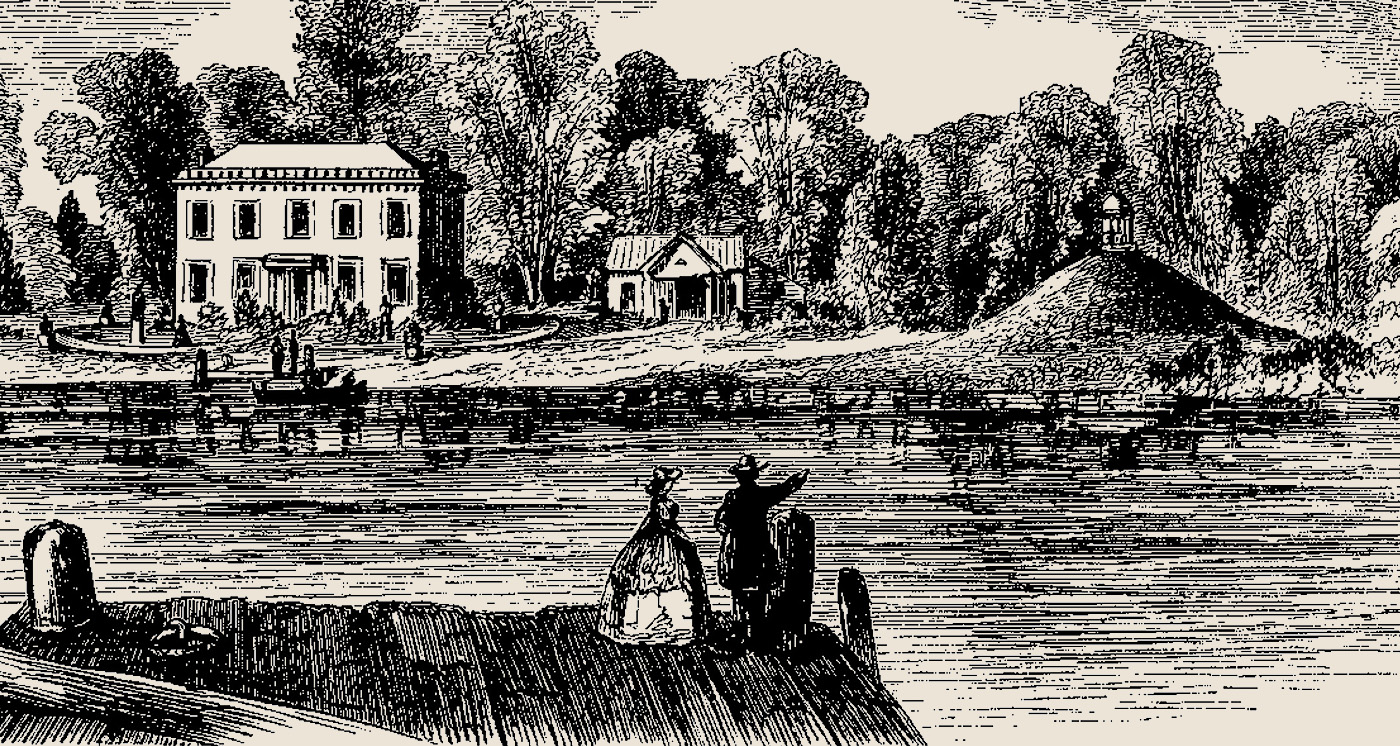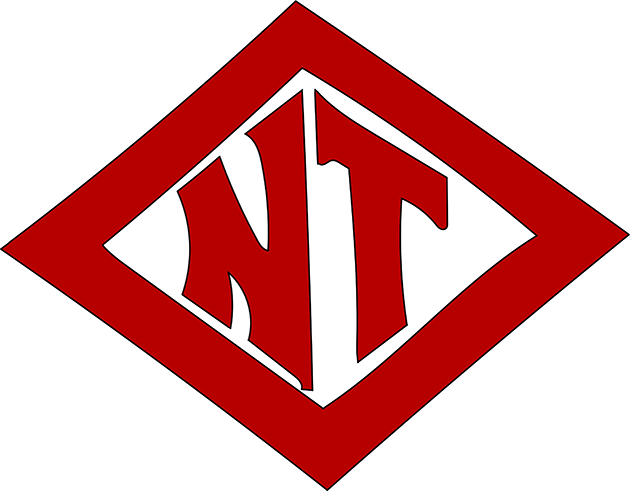Tonawanda Island
Dublin Core
Title
Description
 1860 illustration showing the southern tip of Tonawanda Island. The lavish Beechwater residence and a smaller building are seen to the left of a mysterious mound (Harper's Monthly Magazine, May 1860) This small island in the Niagara River is today home to the N.T. (Water) Pumping Station, Taylor Devices, a booming feral cat population and (we expect) a very few skillful mice. But a mysterious structure at the south end of the island drew some of the earliest widespread attention to our area.
1860 illustration showing the southern tip of Tonawanda Island. The lavish Beechwater residence and a smaller building are seen to the left of a mysterious mound (Harper's Monthly Magazine, May 1860) This small island in the Niagara River is today home to the N.T. (Water) Pumping Station, Taylor Devices, a booming feral cat population and (we expect) a very few skillful mice. But a mysterious structure at the south end of the island drew some of the earliest widespread attention to our area.Early explorers encounter burial mounds left by Native Americans. Or giants.
Early European explorers notice a roughly 15 foot-high mound of earth near the southeastern end of the island. One explorer dates the peculiarity to the Native American Squawkie Hill phase (100-400 A.D.), which "included a religious aspect involving the burial of high-status individuals" (John Percy).
Indeed, human remains are discovered within, though there is little consensus on who (or what) they were. In 1853, Gleason's Pictorial reports that resident Mrs. White (more on the Whites below) personally unearthed "the skull and bones of a human body, supposed to be an Indian chief...not...less than eight feet in stature." (The article adds vaguely that "Many other curiosities are found on the island.") An 1860 article in Harper's tells of "several heaps of bones, each comprising three or four skeletons" found just under a circle of stones with indications of fire. Modern mysteriophile Mason Winfield points to sensational accounts in frontier newspapers claiming at least two "very bizarre skulls" were excavated from the enclosure, with a "portentous, protruding lower jaw and canine forehead," and buried in a way inconsistent with the traditions of the locals. An 1865 presentation before the Buffalo Historical Society claims the mounds are of Neutral Nation origin:
Once in every ten years the survivors of each family gathered the remains of their deceased ancestors from the platforms on which they had been deposited, and buried them in heaps, with many superstitious ceremonies. This was called the " Feast of the Dead." Many of the mounds thus raised may still be seen in this vicinity. A conspicuous one on Tonawanda Island, is affirmed by the old Senecas to have had such an origin.The skeletons are not confined to the great mound, either. Yet more human remains are found while digging the foundations for the Beechwater mansion, the Tonawanda News reports in 1906.
Across the Little River, on the mainland, evidence of a Native American armory is discovered, with numerous broken flints and arrows.
Earliest birth on the island? (From The Niagara Frontier, p. 29)
The Senecas have a different name for Tonawanda Is land. They call it Ni-ga -we-na/i--a-ah, signifying The Small Island. It contains less than one hundred acres. Its upper end having a fine elevation above the surface of the river, was an occasional camping ground of the Senecas, before their final settlement in this region. Philip Kenjockety (hereafter more particularly noticed), claims to have been born there, while his father s family, then residing on the Genesee, were on one of their annual hunting expeditions.
Carney's Island (1791)
The island's first European inhabitant arrives as early as 1791, one Edward Carney, who hopes to "squat" his way into possession of the island. The property's value skyrockets however when Mordecai Noah's plan to turn nearby Grand Island into a refuge for the world's displaced Jews gets underway around 1825, and the land is purchased at auction from the state by Samuel Leggate of New York City (Lockport Union-Sun & Journal).
Stephen White's Island and the Beechwater mansion (1833)
The next speculators to turn their eyes to our area are the moneyed men of the East Boston Timber Company in 1833. They harvest the white oak of Grand Island to build ships in New England. President Stephen White purchases Tonawanda Island as a headquarters and residence, and it becomes known as "White's Island."
To cement his claim, White built a magnificent mansion at the southern end of the island. “Beechwater,” as White called it, was designed by Boston architect Samuel Perkins in 1835 for $18,000. The interior contained cherry, black walnut and marble embellishments (Lockport Union-Sun & Journal)The Beechwater mansion boasts "chimney pieces from Italy," surrounding pleasure grounds with "choice fruits, ornamental shrubbery and graveled walks," and was called the finest residence in Western New York at the time. Famous American lawyer and politician Daniel Webster (after whom Webster Street is named) visits Beechwater on several occasions. Webster's son Fletcher is married to White's daughter Caroline there in 1836.
Further plans of the East Boston Timber Company are thwarted by a poor economy. By 1840 the white oak of Grand Island has been cut down and floated away to New England. Stephen White dies, and his widow stays on.
Summer resort and pleasure grounds
Beechwater is offered as a summer resort beginning around this time. Local organizations come to Tonawanda Island for picnics by the hundreds, brass band blaring away as the tugs pull their boats to the platforms. Writer N.P. Willis extols its beauty in an item in this collection. Some propose turing the island into a sportsmen's paradise: other a military training ground.
William Wilkeson purchases the property from the White family in 1869, planting orchards and vineyards. There are some rumors the old mansion is haunted.
Lumber and industrial era
In 1881, William Wilkeson sells the property to Smith, Fassett & Company, one of the many lumber concerns flocking to the Tonawandas. The natural harbor of the Little River make the island and opposite shore perfect for stacking, processing and shipping immense quantities of lumber, and North Tonawanda has become a major lumber market.
The ferry that operated will no longer be adequate. Apr 21 1883 "An act to incorporate the Tonawanda Island Bridge Company, for the purpose of constructing and operating a bridge from Tonawanda island to North Tonawanda [passed]" - Gen Statutes of State of New York.
Beechwater, Stephen White's mansion, coexists for a while with the lumber around it: "The mansion is now [1887] the home of Mr. and Mrs. Theodore S. Fassett, who have renovated it and thoroughly restored its decaying beauties."
National Guard billeted there during a labor uprising. Although said to still be largely structurally sound, the mansion is torn down in 1906, as the "demand for lumber yardage makes its razing imperative." It was long been rumored to be haunted. A section of its fireplace is preserved and cared for by the Historical Society of the Tonawandas.
Later significant occupants of Tonawanda Island include the International Paper Company and the R. T. Jones Lumber company.
Emile Durkee Bridge.
Source
Relation
Items
White, Stephen J. (?-?).per

Stephen J. White seems to have some suspicion around him regarding the salacious murder of his slave-trading uncle, Captain Joseph White (others…
Carney, James (1800-1881).jpg

From History of Niagara County 1821-1878 (1878): James Carney was a pioneer in the town as early as 1819, locating with his father, Edward Carney,…
Mansion house and Indian Mound on Tonawanda Island, map detail (1837).jpg

Stephen White's Beechwater.
Tonawanda Island for a fishing and sporting club, article, transcribed (On Dits in Sporting Circles, 1844-04-13).jpg

AI Summary:
A call for ten or more gentlemen to form a club and purchase Tonawanda Island, a 100‑acre river island eleven miles above the Falls,…
Account of Indian mound, armory on Tonawanda Island, excerpt (Pioneer History of the Holland Purchase of Western New York, 1849).jpg

Tonawanda Island description, N. P. Willis (Ephemera, Complete Works of N. P. Willis, c. 1850), transcription.jpg

Apropos—I observe a spot advertised for sale that I have always looked upon as the most beautiful and aristocratic property in this country—an island…
Tonawanda, or White's Island, illustrated article (Gleason's Pictorial Drawing Room Companion, 1853).jpg

Ancient monuments in the United States, illustration and article (E. G. Squier, Harper's Monthly Magazine, May 1860).jpg

Tonawanda Island, Its Origins and Early Occupants, article and transcription (Buffalo Courier, 1887-10-09).jpg

TONAWANDA ISLAND.
Its Origin and Early Occupants, Both Red and White.
The Famous Murder of One of Its Owners. His Successor's Elegant Mansion,…
Beechwater, "The Haunted Camp," with 65th regiment, photo article detail (Buffalo Morning Express, 1893-06-25).jpg

White House relic to be demolished soon, article (Tonawanda News, 1906-03-17).jpg

Description of Daniel Webster's visits, and Uncle Vandervoort's store on Grand Island. A 1982 article claims: "Today, all that remains of its former…
No longer roam house - White mansion torn down, article, transcription (Tonawanda News, 1907-04-08).jpg

NO LONGER ROAM HOUSE
Ghosts of the Haunted White Mansion Are Now Without a Home.
BUILDING IS TORN DOWN
Historic Landmark Where Daniel Webster…
Tonawanda Island, aerial photo set (Joseph Blake, 2016-06-15).jpg

A set of aerial photographs showing Tonawanda Island and the Little River.
History of Tonawanda Island - Douglas P. Taylor.doc

(Radio Show Script Third Draft) BY DOUGLAS P. TAYLOR The Beginnings: Tonawanda Island is an 85-acre island located in the East Branch of the…













